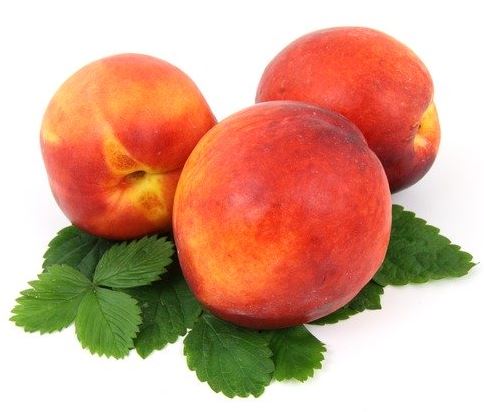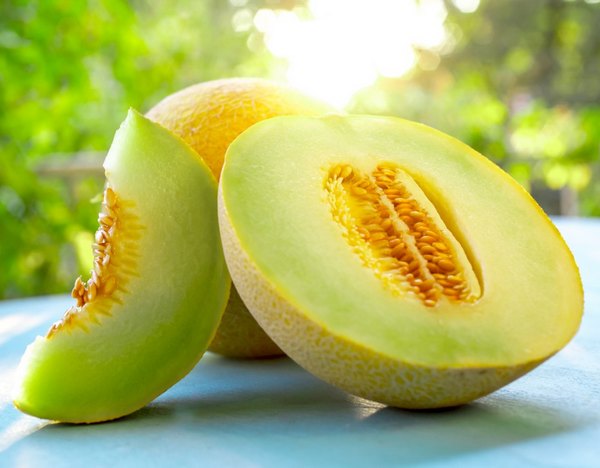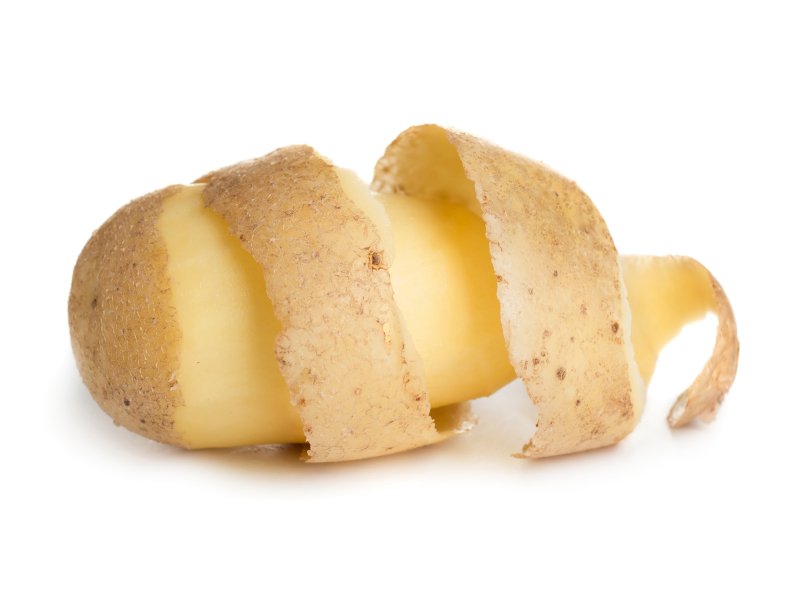Unique properties and benefits of brown rice
The benefits of brown rice include improving the cardiovascular system’s function, gastrointestinal tract, brain, and nervous system. It is full of powerful antioxidants that relieve a wide range of ailments such as high blood pressure, unhealthy cholesterol levels, stress, depression, and skin disorders. The presence of nutrients in this rice has been proven to be effective in various medical conditions such as cancer, obesity, diabetes, neurogenic disorders, and insomnia. It has anti-depressant properties and contributes to healthy bones and a robust immune system.
What is brown rice?
This rice is prepared from pure and unrefined grains by removing the husk around the rice kernel. Its seeds preserve bran, nutrients, and plant layers. Compared to white rice, it needs more chewing and has a pleasant aroma.
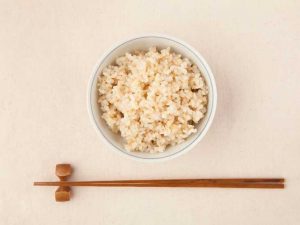
Brown rice sprouts:
The germ of this rice is another common form of brown rice that increases its nutritional value. The nutrient content of this germinated rice is due to amino acid gamma butyric acid. Sprouts can be obtained by soaking and sprouting rice in water at a specific time. This method is intended to obtain the maximum amount of GABA and increase the level of good proteins and enzymes in this rice’s sprouts.
The germination process significantly increases the essential components such as ferulic acid, lysine, magnesium, potassium, vitamin E, niacin, vitamin B6, thiamine, and dietary fiber in brown rice. These nutrients help to absorb digestion better and prevent intestinal irritation, inflammation, and allergies. It can be kept dry to increase its shelf life without affecting its nutritional value.
Why do you eat “brown” rice?
Many of us know that this rice is better than white rice because of the quality and quantity. The process of turning brown rice into white rice further destroys its nutritional value. Therefore, it retains a vast treasure trove of ingredients. There are several types of brown rice on the market with unique flavors, aromatic components, and different fatty acids concentrations.
Facts and nutritional value of brown rice:
According to the National Food Database, brown rice flour is a healthy food rich in essential minerals such as manganese, iron, zinc, phosphorus, calcium, magnesium, and potassium. Vitamin B1 (thiamine), vitamin B2 (riboflavin), vitamin B3 (niacin), vitamin B6, folic acid, vitamin E (alpha), and vitamin K are sources of protein and add a lot of fiber to the diet. Also, it provides essential fatty acids.
Benefits of brown rice:

Diabetes control
This rice is useful for diabetics and hypoglycemics. It has a low glycemic index, which is useful in reducing insulin resistance and stabilizing blood sugar levels in the body.
A comparative study published in the International Journal of Nutrition found that it is rich in phytic acid, fiber, and polyphenols. It is a complex carbohydrate that helps to reduce sugar compared to white rice gradually. The American Diabetes Association also advises people with diabetes to choose brown rice to meet their dietary needs for vitamins, fiber, and minerals.
Antioxidant activity
Brown rice is rich in powerful antioxidants that protect against damage caused by oxygen free radicals. It contains an important antioxidant enzyme called superoxide dismutase, which protects cells from oxidative damage during energy production. A research study in the Malaysian Journal of Medical Sciences includes white and brown rice, which shows that it helps prevent various oxidative diseases, such as cardiovascular disease.
Prevents obesity
Brown rice is a tool for weight control in people who are struggling with obesity. It contains manganese, which helps produce body fat. A study conducted in this field showed that all cereals such as rice and black rice positively affect the body due to reduced body mass and fat index and glutathione peroxidase’s growth activity. This antioxidant enzyme raises acceptable cholesterol levels.
Prevent Alzheimer’s
A 2013 study found that brown rice sprouts prevent neurological complications such as Alzheimer’s disease due to gamma acid. This rice contains beneficial substances that help inhibit harmful enzymes, which are associated with Alzheimer’s disease. It is also useful for other brain disorders such as insanity and forgetfulness.
Reduce stress in breastfeeding women
Brown rice sprouts are good for breastfeeding mothers. A research study in the European Journal of Nutrition has shown that its use can show positive breastfeeding women due to reduced mental disorders, stages of depression, and fatigue. It is also said that consuming this rice during breastfeeding increases the body’s ability to resist stress and improves overall immunity.
Improve gastrointestinal health
This rice is useful and can be added to the daily diet to maintain a healthy digestive system. The fiber in it helps regulate bowel function and keeps you full. A qualitative study on the effects of white rice and brown rice on gastric digestion showed that rice bran prevents acid and moisture absorption, leading to better tissue preservation. Fiber content also prevents other diseases such as constipation and colitis.
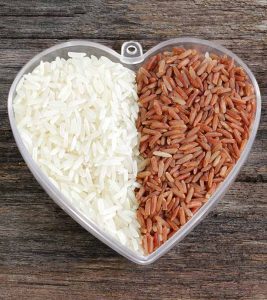
Improve heart health
This rice is rich in selenium, which is useful for improving the heart. Consumption of grains such as brown rice helps reduce arterial blockage due to plaque accumulation. This protective measure reduces the risk of heart disorders such as high blood pressure and vascular disease. Studies have shown that the tissues around the grain of this rice play an important role in endocrine protein, angiotensin, in causing high blood pressure and atherosclerosis.
Control cholesterol levels
Brown rice is a good option for maintaining healthy cholesterol levels due to the presence of natural oils. A research study showed that this substance has the property of lowering blood sugar and thus regulates cholesterol control. It contains beneficial nutrients that help with fat and glucose metabolism. Consumption of this rice in people who use chronic ethanol has significantly improved serum and good cholesterol. Its buds have also been shown to help prevent the accumulation of fat in the liver.
Cancer prevention
Brown rice is useful in preventing colon cancer, breast cancer, and leukemia. This beneficial effect can be considered due to potent antioxidants and high fiber content in it. The fiber content of this rice can join deadly cancers that cause toxins in the body. This prevents toxins from sticking to the intestinal wall and helps expel them from the body.
A research study evaluating brown rice properties found that its bran contains essential phenols such as tricin, ferulic acid, and caffeic acid, found in lower white rice levels. These phenolic components are valuable in inhibiting the proliferation of colon and breast cancer cells. Another study showed the effect of this rice sprout on cell death and its inhibitory effects on blood cancer cells’ production. Also, research has confirmed the antitumor effects of brown rice in the diet.
Improves the function of the nervous system
This rice is useful for the soft function of the brain and nervous system. B vitamins and essential minerals such as manganese and magnesium help the rapid metabolism of the brain. These essential minerals maintain calcium activity in the body and help regulate nerves and muscles. It also prevents a sudden increase in calcium in nerve cells and nerve activation, which helps maintain nerves and muscles and prevents excessive contraction—Vitamin E plays a vital role in preventing various brain diseases caused by oxidative damage.
Anti-depressant properties
Brown rice sprouts have anti-depressant properties and help fight depression-related disorders. A research study showed that these rice sprouts contain essential amino acids such as glutamine and glycerin. These neurotransmitters prevent the storage of messages related to anxiety, depression, and stress in the brain and lead to a state of relaxation.
Improves insomnia
Brown rice is useful in treating insomnia because it is a natural source of sleep hormone. Improves sleep quality by calming the nerves and increasing the sleep cycle.
Improved safety
This rice contains significant amounts of vitamins, minerals, and essential phenolic components that strengthen the immune system. It nourishes the body, speeds up recovery, and increases its ability to fight infection.
Improve bone health
Brown rice is good for bone health. It is rich in magnesium, which together with calcium provides the physical structure of bones. This magnesium-rich rice prevents bone mineralization and is useful for diseases such as osteoarthritis and osteoporosis.
How to choose and preserve good brown rice?
This rice contains natural oils that can age if stored for a long time. It is recommended to check its date and consume it fresh. You can store raw brown rice in a container full of air at room temperature for up to six months to keep it healthy. It can be stored in the refrigerator to extend its life. This rice must be carefully stored.
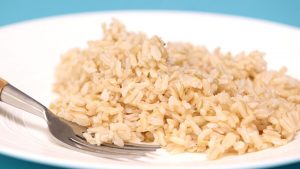
How to cook brown rice?
Brown rice takes a long time to cook and requires more water due to its outer fiber coating. For one cup of rice, you can use two and a half to three cups of water. It was soaking rice before cooking reduces cooking time. This rice takes about 35 to 40 minutes to prepare.
This rice is suitable for many organs, including the heart, digestive system, brain, bones, cholesterol, and blood pressure. This rice cures diseases such as psoriasis and hair loss to improve the skin. It has anti-aging properties, which are an antioxidant due to the presence of ferulic acid. Brown rice is rich in folic acid, which is essential for the fetus’s healthy growth during pregnancy. A small amount of this rice is also recommended for patients suffering from infections.
Rice is a varied grain that is important to many people around the world. There are different rice types, but it is white and brown, generally eaten and healthy. Talk to your doctor to make sure you have enough fiber in your diet.
Full comparison of white or brown rice: which is healthier?
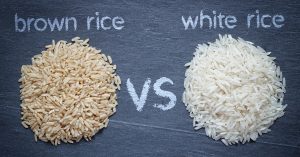
Brown rice
This rice contains all parts of wheat: bran (full of fiber), sprouts, and endosperm (rich in carbohydrates), whole grains are considered. Research shows that whole foods can lower cholesterol, reduce the risk of stroke, heart disease and type 2 diabetes and make it a healthier option.
White rice
The process on rice destroys the rice bran and sprouts and causes them to turn white.
Nutritional Value:
So which brown or white rice is healthier and which one do you choose?
Brown rice is recommended for a healthy diet because it contains more nutrients.
Brown rice has more calories but contains extra protein and fiber that have health benefits, such as:
- Cholesterol-lowering
- Control your blood sugar levels
- Nutrition of intestinal bacteria
- Help you feel fuller.
According to research published in the International Journal of Endocrinology, magnesium is also a good source of selenium, which plays a vital role in thyroid hormone production, antioxidant production, and immune function magnesium, which helps with muscle contraction and bone growth.
White rice fortified with folic acid is recommended for pregnant and lactating women. Folic acid helps the body produce DNA and other genetic material and supports cell division. White rice usually has more calcium and iron for enrichment. While all rice can be an essential energy source, brown rice contains more nutrients and has more health benefits. Talk to your doctor or nutritionist to make sure you have enough fiber in your diet.
This rice is right for you and is a recommended food to improve eating habits and overall health. However, athletes often follow different diets depending on their diet. This includes eating white rice as the primary source of carbohydrates for fast energy and glycogen supply. Athletes try to lose weight and need lots of carbohydrates to fuel their bodies.
Although eating white rice is considered unhealthy, athletes and weightlifters ignore any adverse claims. They usually consume white rice as an essential part of their diet. The goal of exercise and weightlifters is to provide adequate amounts of high-nutrient nutrients for strenuous exercise and replenish glycogen stores. White rice plays a significant role in this process and is a great sports food for these athletes.
Carbohydrates also replenish muscle glycogen after strenuous exercise. One of the most common meals for weightlifters is a large bowl of white rice with fried chicken breast.
According to the Journal of Sports Science, ranking carbohydrate-rich foods on the glycemic index provides the available carbohydrates for muscle glycogen synthesis. Hard training significantly refines sugar (glycogen) in the muscles and nourishes the right carbohydrates.
White rice has a high glycemic index. This means how foods affect blood sugar and insulin levels. According to an article in the Journal of Sports Medicine, it is essential to know how to get carbs during long-term exercise, which is why research into carbohydrate intake in athletes dominates sports nutrition.
Also Read:



